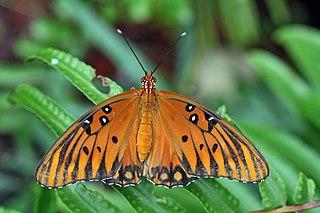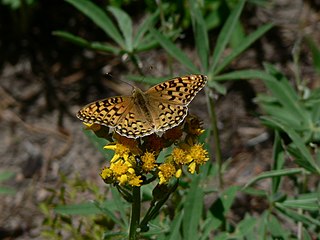
The Gulf fritillary or passion butterfly is a bright orange butterfly in the subfamily Heliconiinae of the family Nymphalidae. That subfamily was formerly set apart as a separate family, the Heliconiidae. The Heliconiinae are "longwing butterflies", which have long, narrow wings compared to other butterflies.

The speckled wood is a butterfly found in and on the borders of woodland areas throughout much of the Palearctic realm. The species is subdivided into multiple subspecies, including Pararge aegeria aegeria, Pararge aegeria tircis, Pararge aegeria oblita, and Pararge aegeria insula. The color of this butterfly varies between subspecies. The existence of these subspecies is due to variation in morphology down a gradient corresponding to a geographic cline. The background of the wings ranges from brown to orange, and the spots are either pale yellow, white, cream, or a tawny orange. The speckled wood feeds on a variety of grass species. The males of this species exhibit two types of mate locating behaviors: territorial defense and patrolling. The proportion of males exhibiting these two strategies changes based on ecological conditions. The monandrous female must choose which type of male can help her reproduce successfully. Her decision is heavily influenced by environmental conditions.

Heliconius charithonia, the zebra longwing or zebra heliconian, is a species of butterfly belonging to the subfamily Heliconiinae of the family Nymphalidae. It was first described by Carl Linnaeus in his 1767 12th edition of Systema Naturae. The boldly striped black and white wing pattern is aposematic, warning off predators.

Dryas iulia, commonly called the Julia butterfly, Julia heliconian, the flame, or flambeau, is a species of brush-footed butterfly. The sole representative of its genus Dryas, it is native from Brazil to southern Texas and Florida, and in summer can sometimes be found as far north as eastern Nebraska. Over 15 subspecies have been described.

Speyeria zerene, the zerene fritillary, is a butterfly found in the western portions of the United States and Canada. The species was first described by William John Swainson in 1827.

The pearl-bordered fritillary is a butterfly of the family Nymphalidae found in Europe and through Russia across the Palearctic to the north of Kazakhstan.

The Queen of Spain fritillary is a butterfly of the family Nymphalidae.

The great spangled fritillary is a North American butterfly of the family Nymphalidae.

Speyeria hydaspe, the Hydaspe fritillary, is a species of orange-brown butterfly found in the western portions of the United States and Canada. A small fritillary, it usually has cream-colored underwing spots, but the Vancouver Island subspecies has silver spots. It is similar to S. zerene and S. atlantis, but may be distinguished by the smooth and even appearance of its postmedian spotband. The caterpillars feed on violets including Viola glabella. A single brood flies from July through September and feeds on flower nectar. They may be found in moist forests, in clearings and subalpine meadows.

Mud-puddling, or simply puddling, is a behaviour most conspicuous in butterflies, but occurs in other animals as well, mainly insects; they seek out nutrients in certain moist substances such as rotting plant matter, mud and carrion and they suck up the fluid. Where the conditions are suitable, conspicuous insects such as butterflies commonly form aggregations on wet soil, dung or carrion. From the fluids they obtain salts and amino acids that play various roles in their physiology, ethology and ecology. This behaviour also has been seen in some other insects, notably the leafhoppers, e.g. the potato leafhopper, Empoasca fabae.

The Diana fritillary is a fritillary butterfly found in several wooded areas in southern and eastern North America. The species exhibits marked sexual dimorphism, with males of the species exhibiting an orange color on the edges of their wings, with a burnt orange underwing. Females are dark blue, with dark, almost dusty underwings, and are also larger than males.

The callippe silverspot butterfly is a federal endangered species in the brush-footed butterfly family Nymphalidae. This is a subspecies. It is a member of the Heliconiinae, the subfamily known as longwings. The adult has a wingspan of just over two inches. The wings are eyecatching with a brown, tan, and black scalloped pattern on their surfaces and orange-brown with characteristic silver spots on the undersides. The wings and abdomen are hairy. The larvae are spiny, dark-colored caterpillars.

Myrtle's silverspot is a medium-sized butterfly in the brush foot family (Nymphalidae), an endangered subspecies of the zerene fritillary. It is endemic to California, where it is known from only about four locations just north of the San Francisco Bay Area, including two at Point Reyes National Seashore. Its wingspan is approximately 2.2 inches (56 mm). The upper surfaces of the wings are golden brown with numerous black spots and lines. The undersides are brown, orange and tan with black lines and silver and black spots. Larvae are dark colored with many sharp branching spines on their backs. Myrtle's silverspot is larger and paler than the closely related Behrens' silverspot, which is now limited to the vicinity of Point Arena in Mendocino County. Myrtle's silverspot is also closely related to the Oregon silverspot.

The regal fritillary is a striking nymphalid butterfly found among some of the remaining tallgrass and mixed-grass prairies in the east-central United States. This prairie-specialist butterfly has a characteristic deep orange color and unmistakable dark hindwings with two bands of spots. On the female, both bands of spots are white. However, on the male, the outer band of spots is orange in color. Females also tend to be slightly larger than males. The ventral surface of the hindwings is olive brown to black in color with bold silvery white spots. The wingspan of S. idalia usually measures 68–105 millimetres (2.7–4.1 in). Flight is in the summertime from approximately June to September and adults tend to be swift in flight, coasting close to the ground. It is listed as a species of special concern and believed extirpated in the US state of Connecticut.

The variable checkerspot or Chalcedon checkerspot is a butterfly in the family Nymphalidae. It is found in western North America, where its range stretches from Alaska in the north to Baja California in the south and extends east through the Rocky Mountains into Colorado, Montana, New Mexico and Wyoming. The butterfly is usually brown or black with extensive white and yellow checkering and some red coloration on the dorsal wing. Adult wingspan is 3.2–5.7 cm (1.3–2.2 in). Adult butterflies feed on nectar from flowers while larvae feed on a variety of plants including snowberry (Symphoricarpos), paintbrush (Castilleja), Buddleja, Diplacus aurantiacus and Scrophularia californica.

Asterocampa celtis, the hackberry emperor, is a North American butterfly that belongs to the brushfooted butterfly family, Nymphalidae. It gets its name from the hackberry tree upon which it lays its eggs. The hackberry tree is the only host plant for A. celtis and is the food source for larvae.

Euptoieta claudia, the variegated fritillary, is a North and South American butterfly in the family Nymphalidae. Even though the variegated fritillary has some very different characteristics from the Speyeria fritillaries, it is still closely related to them. Some of the differences are: variegated fritillaries have two or three broods per year vs. one per year in Speyeria; they are nomadic vs. sedentary; and they use a wide range of host plants vs. just violets. And because of their use of passionflowers as a host plant, variegated fritillaries also have taxonomic links to the heliconians. Their flight is low and swift, but even when resting or nectaring, this species is extremely difficult to approach, and, because of this, its genus name was taken from the Greek word euptoietos meaning "easily scared".

Bicyclus anynana is a small brown butterfly in the family Nymphalidae, the most globally diverse family of butterflies. It is primarily found in eastern Africa from southern Sudan to Eswatini. It is found mostly in woodland areas and flies close to the ground. Male wingspans are 35–40 mm and female wingspans are 45–49 mm.

Speyeria adiaste, the unsilvered fritillary or adiaste fritillary, is a species of butterfly of the family Nymphalidae. It is found in California north to San Mateo County and east to north Los Angeles County and Kern County.

Carol Linda Boggs is an American biologist specializing in the reproductive biology, population biology, ecology, and evolution of butterflies. Boggs completed her BA in 1973 and her PhD in 1979 in zoology at the University of Texas at Austin. Since 2013, she has been a professor in the School of the Earth, Ocean and Environment and the Department of Biological Sciences at the University of South Carolina. Boggs is the author of more than 120 peer-reviewed articles and has served on editorial boards for several journals. She has been a fellow of the American Association for the Advancement of Science since 2001.




















